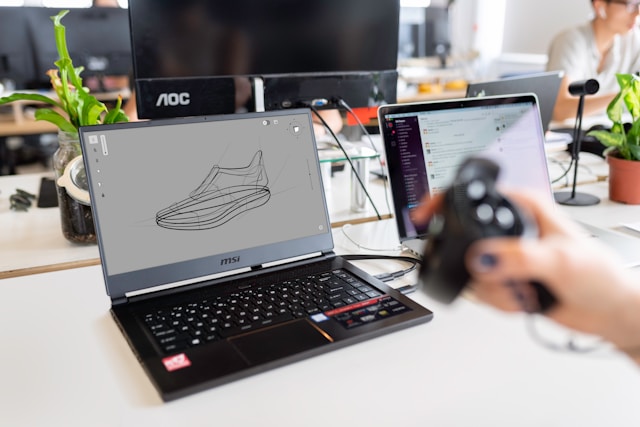
I. Introduction
The Evolution of UX/UI Design Software
The field of User Experience (UX) and User Interface (UI) design has witnessed remarkable transformations over the years, driven by technological advancements and changing design philosophies. This section explores the journey of UX/UI software and sets the stage for a discussion on its future.
The Impact of Emerging Technologies
Examining the influence of emerging technologies on the current state of UX/UI design software lays the foundation for predicting how these tools will continue to evolve.
II. Current Trends in UX/UI Design Software
The Rise of Collaboration Tools
Collaboration is increasingly becoming a focal point in design processes. Modern UX/UI design software emphasizes real-time collaboration features, allowing designers, developers, and stakeholders to work seamlessly across geographical boundaries.
Integration of AI and Machine Learning
The integration of Artificial Intelligence (AI) and Machine Learning (ML) is heralding a transformative era in UX/UI design, revolutionizing the way digital experiences are crafted and optimized. This dynamic fusion of cutting-edge technologies is reshaping traditional design processes, offering innovative solutions to enhance user interfaces and overall user experiences.
In the realm of UX/UI design, the utilization of AI brings forth a paradigm shift by introducing intelligent automation. Designers are empowered to automate routine and time-consuming tasks, allowing them to allocate their creative energy towards more intricate and strategic aspects of design. This not only expedites the design process but also elevates the quality of output by reducing the potential for human errors in repetitive tasks.
Responsive Design for Multi-Platform Experiences
With the proliferation of diverse devices, responsive design features prominently in contemporary UX/UI design software. Tools that facilitate designing for various screen sizes and resolutions are crucial for creating consistent and enjoyable user experiences.
Adoption of Augmented Reality (AR) and Virtual Reality (VR)
The surge in popularity of Augmented Reality (AR) and Virtual Reality (VR) technologies is catalyzing a significant evolution in UX/UI design, prompting a transformation in the capabilities of design software. As these immersive technologies gain momentum, designers are now seeking innovative tools that empower them to prototype and visualize interfaces within three-dimensional spaces.
The integration of AR and VR in UX/UI design marks a departure from traditional two-dimensional design approaches. Designers are increasingly harnessing the power of these technologies to create interactive and engaging user experiences that transcend the limitations of flat interfaces. In this new landscape, the design process extends beyond mere visual aesthetics to encompass the spatial and interactive dimensions inherent in AR and VR environments.
III. The Future Landscape of UX/UI Design Software
Enhanced Collaboration Capabilities
The future of UX/UI design software will see an even more pronounced emphasis on collaboration. Real-time editing, interactive prototyping, and shared design systems will become standard features, fostering a more streamlined and efficient design process.
AI-Driven Design Assistance
As AI continues to mature, UX/UI design software will provide more sophisticated design assistance. From generating design suggestions based on user preferences to automating tedious tasks, AI will become an indispensable companion for designers.
Seamless Integration of AR and VR Prototyping
The integration of AR and VR prototyping tools will be seamless, allowing designers to create and test immersive experiences within the same software. This shift will enable a more holistic approach to designing for emerging technologies.
Personalized User Experiences at Scale
Future UX/UI design software will prioritize scalability and personalization. Designers will have the tools to create adaptive interfaces that cater to individual user preferences, providing a more engaging and tailored experience.
IV. Challenges and Considerations
Balancing Automation with Creativity
The increasing role of AI raises questions about finding the right balance between automation and human creativity. Designers will need to navigate the challenges of leveraging AI while preserving the unique, human touch in their creations.
Addressing Ethical Implications
As AI becomes more involved in the design process, addressing ethical considerations, such as bias in algorithms and data privacy, will be paramount. Design software developers will need to implement safeguards to ensure responsible and inclusive design practices.
Learning Curve and Accessibility
The evolution of UX/UI design software may introduce more complex features. Striking a balance between advanced capabilities and ensuring accessibility for designers of varying skill levels will be essential to democratize the use of these tools.
Keeping Pace with Rapid Technological Advancements
The dynamic nature of technology poses a challenge for UX/UI design software developers. Staying ahead of the curve and incorporating the latest advancements without overwhelming users will be crucial for the continued success of these tools.
V. The Role of Designers in Shaping the Future
Embracing Lifelong Learning
Designers must adopt a mindset of lifelong learning to stay abreast of technological advancements. Continuous education and upskilling will empower them to harness the full potential of evolving UX/UI design software.
Advocating for Ethical Design Practices
Designers play a pivotal role in advocating for ethical design practices. By actively engaging in discussions about the ethical implications of emerging technologies, they contribute to the development of responsible and inclusive design software.
Collaborating Across Disciplines
The future of UX/UI design software will require designers to collaborate seamlessly with professionals from diverse fields. Cross-disciplinary collaboration will be essential for addressing complex challenges and creating well-rounded user experiences.
Embracing Creativity in the Age of Automation
While AI assists in various aspects of the design process, designers should embrace their creativity as an irreplaceable asset. The human touch in design, including intuition and emotional intelligence, will continue to set the work of designers apart.
VI. Conclusion
The future of UX/UI design software holds exciting possibilities, fueled by the relentless march of technology. From enhanced collaboration and AI-driven assistance to seamless integration of emerging technologies, designers are on the brink of a transformative era. As the landscape evolves, designers must adapt, advocate for ethical practices, and continue to champion creativity in the ever-evolving realm of UX/UI design software. Explore Component Price for more UX/UI design software options.





